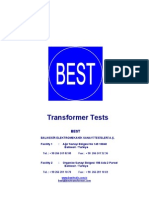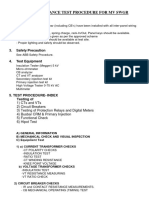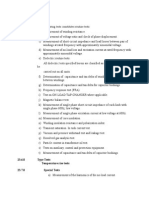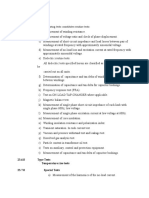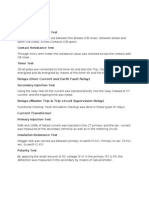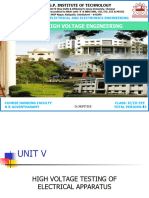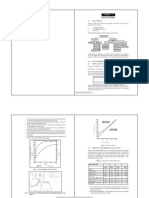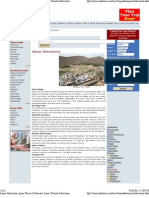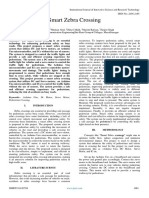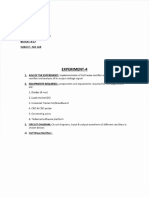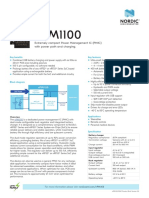Testing Procedure For Switch Yard Equipments 1
Testing Procedure For Switch Yard Equipments 1
Uploaded by
d_kabulpuriaCopyright:
Available Formats
Testing Procedure For Switch Yard Equipments 1
Testing Procedure For Switch Yard Equipments 1
Uploaded by
d_kabulpuriaOriginal Title
Copyright
Available Formats
Share this document
Did you find this document useful?
Is this content inappropriate?
Copyright:
Available Formats
Testing Procedure For Switch Yard Equipments 1
Testing Procedure For Switch Yard Equipments 1
Uploaded by
d_kabulpuriaCopyright:
Available Formats
TESTING PROCEDURE OF SWITCH YARD EQUIPMENTS
TESTING PROCEDURE OF SWITCH YARD EQUIPMENTS 1.Switchyard Equipments:- All Equipments in the Switchyard will be checked for nameplate details as per the SLD provided by the client. This also includes checking of earthing connections to the body of the equipments and proper connections, tightness of all connections, as per drawing provided. 2. Control and Relay Panel :- The Cubicle will be checked with the drawing provided. This also includes checking of earthing connections to the body of the panel and proper connections, tightness of all CT & PT , control connections of breaker , as per drawing provided and testing of relays, meters, switches provided as per SLD . 3. After completion of above procedure continuity for all the equipment for its terminal to its respective Junction box and from the junction box to the CRP will be checked. 4. CT Testing Procedure: - The Following test will be carried out on CTs. 4a. Insulation Resistance test. 4b. Polarity test. 4c. Ratio Test. 4d. Winding Resistance only of PS class core. 4e. Knee Point voltage only of PS class core. 5. PT Testing Procedure: - The Following test will be carried out on PTs. 5a. Insulation Resistance test. 5b. Polarity test. 5c. Ratio Test. 6. Breaker Testing Procedure: - The Following test will be carried out on Breakers. 6a. Insulation Resistance test. 6b. Contact Resistance test. 6c. Breaker Operational check. 6d.Primary Injection and tripping of breaker. 6e. Relay Testing. 6f. Functional check of indicating lamps and indicating meters. 7. Isolator Testing Procedure: - The Following test will be carried out on Isolators. 7a. Insulation Resistance test. 7b. Contact Resistance test. 7c. Isolator Earth rod continuity test. 7d. Isolator Operational and interlock checks. 8. Lightning Arrestor Testing Procedure: - The Following test will be carried out on LAs. 8a. Insulation Resistance test. 8b. Surge Counter operational check. 9. Transformer Testing Procedure: - The Following test will be carried out on Transformers. 9a. Insulation Resistance test (Primary to Earth,Primary to Secondary,Secondary to Earth) 9b. Ratio test on All Taps at Reduced Voltage. 9c. Open Circuit Magnetizing Current test at Reduced Voltage.. 9d. Winding Resistance test on Normal Tap. 9e.. Magnetic Balance test at Reduced Voltage. 9f.. Vector Group test at Reduced Voltage. 9g. Control Checks of Tripping by Auxilary Relays.
10. Earth continuity and connection checks for HT Breaker, Transformer, CT & PT , isolator , LAs 11. Cable Testing. 11a. IR Value. 11b. Continuity Check with the phase markings. 12. HT panel testing. 12a. Control and Relay Panel :- The Cubicle will be checked with the drawing provided. This also includes checking of earthing connections to the body of the panel and proper connections, tightness of all CT & PT , control connections of breaker , as per drawing provided and testing of relays, meters, switches provided as per SLD . 12b. After completion of above procedure continuity for all the equipment for its terminal to its respective Junction box and from the junction box to the CRP will be checked. 12c. CT Testing Procedure: - The Following test will be carried out on CTs. a. Insulation Resistance test. b. Polarity test. c. Ratio Test. d. Winding Resistance only of PS class core. e. Knee Point voltage only of PS class core. 12d. PT Testing Procedure: - The Following test will be carried out on PTs. a. Insulation Resistance test. b. Polarity test. c. Ratio Test. 12e. Breaker Testing Procedure: - The Following test will be carried out on Breakers. a. Insulation Resistance test. b. Contact Resistance test. c. Breaker Operational check. d.Primary Injection and tripping of breaker. e. Relay Testing. f. Functional check of indicating lamps and indicating meters. 12f. Cable Testing. a. IR Value. b. Continuity Check with the phase markings.
13.CT Testing Procedure: - The Following test will be carried out on CTs. 13a. Insulation Resistance test Insulation Resistance will done using a 5KV Megger for primary to earth and Primary to secondary terminal and 500V Megger for Secondary to earth and secondary to secondary terminals. 13b. Polarity test Polarity test is carried out by applying a potential across primary P1 P2 and getting a positive deflection on a galvanometer connected across its secondary terminals Such that P1 +ve , P2 ve = s1 +ve, s2 ve
13c. Ratio Test. Ratio test is carried out by passing current through the primary terminal and measuring the secondary current using an multimeter 13d. Winding Resistance test. Winding Resistance is carried out only of PS class core and value is checked with its name plate details. A multimeter is connected across the secondary terminal only and its value in ohms is measured and noted down 14e. Knee Point voltage test. Knee Point voltage test is carried out only of PS class core. Here the condition is if a 10 % rise in voltage gives a 50 % rise in current the CT is said to have reached saturation level. This value found is checked with name plate details. 15. PT Testing Procedure: - The Following test will be carried out on PTs. 15a. Insulation Resistance test. Insulation Resistance will done using a 5KV Megger for primary to earth and Primary to secondary terminal and 500V Megger for Secondary to earth and secondary to secondary terminals. 15b. Polarity test Polarity test is carried out by applying a potential across primary A terminal and getting a positive deflection on a galvanometer connected across its secondary terminals Such that A +ve , N ve = a +ve, n ve 15c. Ratio Test Ratio test is carried out by applying a potential 230V to primary and measuring the secondary potential using a multimeter. 16. Breaker Testing Procedure: - The Following test will be carried out on Breakers 16a. Insulation Resistance test. Insulation Resistance will done using a 5KV Megger for line side terminal to earth, bus side terminal to earth, across its terminal with breaker in open condition and using a 1KV Megger across breaker terminal in closed position. 16b. Contact Resistance Contact Resistance is found using a Micro-ohm meter, which applies Voltage, and current to the contacts for Breaker in closed position and directly gives reading on its display. 16c. Breaker Operational Test Breaker Operational Test consist of the following A: - Operation of breaker in Manual/Electrical/Local/Remote Condition B: - Breaker Tripping in Manual/Electrical/Local/Remote Condition C: - Indication check as provided on breaker and in CRP D: - SF6 Gas alarm & lock out checked at specified pressure. E: - Auxiliary Relay Operation in CRP if Provided F: - Breaker Tripping by relay operation and remote trip.
17. Isolator Testing Procedure: - The Following test will be carried out on Isolators. 17a. Insulation Resistance test. Insulation Resistance will done using a 5KV Megger for line side terminal to earth, bus side terminal to earth with Isolator in open condition and using a 1KV Megger across isolator terminal in closed position 17b. Contact Resistance . Contact Resistance is found using a Micro-ohm meter, which applies Voltage, and current to the contacts for Isolator in closed position and directly gives reading on its display 17c. Isolator Earth rod continuity test. Continuity will be checked with earth switch and ground. 17d. Isolator Operational Test. Isolator Operational Test consist of the following A: - Operation of Isolator in Manual/Electrical/Local/Remote Condition B: - Isolator mechanical / electrical interlocks C: - Indication check as provided on Isolator JB and in CRP D: semaphor operational checks. 18. Lightning Arrestor Testing Procedure: - The Following test will carried out on LAs. 18a. Insulation Resistance test Insulation Resistance will be done using a 1KV Megger for different stacks to earth and across different stacks 18b. Surge Counter operational test. Surge Counter operational will include testing of deflection and operation of counter using a charged capacitor, which will be used to discharge across its terminals 19. Earth Resistance test. Here the values of earth resistance of the earth pit will be tested using a earth tester in which two earth rods will be inserted in the earth where the middle rod will be at equidistance point between the earth pit under test and the other earth rod, the values are directly calculated and shown on the display. 20. Testing procedure for transformers. 20a. transformer insulation resistance will be checked between primary to earth and primary to secondary by 5 KV meggar . Secondary to earth will be checked by 5 KV meggar if the voltage is above 11 kv .if the voltage is LV it will be checked by 1 KV meggar. 20b. voltage ratio will be checked on each tap by applying 415 V on primary side and checking voltage ratio on seconadary side by using multimeter. 20c.open circuit magnetizing current will be checked by using multimeter on primary side by applying 415 V on primary side and keeping seconadary open. 20d.magnetic balance will be checked by applying 415V on priamary and checking the voltages on primary and secondary side as per connections./ 20e. vector group test will be carried out by applying 415 V on priamary side and volatage reading will be taken on primary and secondary as per vector group and connections.
20f. auxiliary relay checking will be carried out by individual relays on transformer upto marshalling box and from marshalling box to relay panel. 21. Cable testing procedure 21a. cable testing is carried out by using 5 Kv meggar IR values taken between phases and between phase and earth.before and after termination. 21b. contuinity and phase marking will be checked by using continuity tester. 22.TESTING PROCEDURE FOR HT Breakers After completion of above procedure the following test are performed 1. CT testing 2. PT testing 3. Breaker testing 4. Secondary Injection Test 5. CT Primary ratio Test 6. PT Primary ratio Test 7. Stability Test for differential and REF 22a.CT Testing Procedure: - The Following test will be carried out on CTs. a. Insulation Resistance test Insulation Resistance will done using a 5KV Megger for primary to earth and Primary to secondary terminal and 500V Megger for Secondary to earth and secondary to secondary terminals. b. Polarity test Polarity test is carried out by applying a potential across primary P1 P2 and getting a positive deflection on a galvanometer connected across its secondary terminals Such that P1 +ve , P2 ve = s1 +ve, s2 ve c. Ratio Test. Ratio test is carried out by passing current through the primary terminal and measuring the secondary current using an multimeter d. Winding Resistance test. Winding Resistance is carried out only of PS class core and value is checked with its name plate details. A multimeter is connected across the secondary terminal only and its value in ohms is measured and noted down e. Knee Point voltage test. Knee Point voltage test is carried out only of PS class core. Here the condition is if a 10 % rise in voltage gives a 50 % rise in current the CT is said to have reached saturation level. This value found is checked with name plate details. 22b. PT Testing Procedure: - The Following test will be carried out on PTs. a. Insulation Resistance test. Insulation Resistance will done using a 5KV Megger for primary to earth and Primary to secondary terminal and 500V Megger for Secondary to earth and secondary to secondary terminals. b. Polarity test Polarity test is carried out by applying a potential across primary A terminal and getting a positive deflection on a galvanometer connected across its secondary terminals
Such that A +ve , N ve = a +ve, n ve c. Ratio Test Ratio test is carried out by applying a potential 230V to primary and measuring the secondary potential using a multimeter. 22c. Breaker Testing Procedure: - The Following test will be carried out on Breakers a. Insulation Resistance test. Insulation Resistance will done using a 5KV Megger for line side terminal to earth, bus side terminal to earth, across its terminal with breaker in open condition and using a 1KV Megger across breaker terminal in closed position. b. Contact Resistance Contact Resistance is found using a Micro-ohm meter, which applies Voltage, and current to the contacts for Breaker in closed position and directly gives reading on its display. c. Breaker Operational Test. Breaker Operational Test consist of the following. A: - Operation of breaker in Manual/Electrical/Local/Remote Condition . B: - Breaker Tripping in Manual/Electrical/Local/Remote Condition. C: - Indication check as provided on breaker and in CRP. D: - SF6 Gas alarm & lock out checked at specified pressure. E: - Auxiliary Relay Operation in CRP if Provided. F: - Breaker Tripping by relay operation and remote trip. 22d.. Secondary Injection Test Current is injected using a relay testing kit through the relay terminal and triping time, tripping is checked as per selected curve. 22e. CT Primary Injection Test Current is injected through the CT Primary terminal and its corresponding value is measured in CRP also tripping of relay is checked. 22f. PT Primary Injection Test Voltage is applied to the PT terminal and its corresponding value is measured in CRP. 22g. Stability Test Secondary of the Transformer LV is shorted (all 3 phase) once to create an in zone fault and then to create an out zone fault and three phase supply is applied to the primary CT P1 Terminals. The difference current in both case is measured in the differential relay. 22h. REF Relay Test Secondary of the Transformer LV is shorted with respect to earth once to create an in zone fault and then to create an out zone fault and single phase supply is applied to the primary PT Terminals. The HV REF, LV REF will be tested for in zone, out zone fault.
23. Breaker Testing Procedure: - The Following test will be carried out on Breakers. 23a. Insulation Resistance test.
Insulation Resistance will done using a 5KV Megger for line side terminal to earth, bus side terminal to earth, across its terminal with breaker in open condition and using a 1KV Megger across breaker terminal in closed position. 23b. Contact Resistance Contact Resistance is found using a Micro-ohm meter, which applies Voltage, and current to the contacts for Breaker in closed position and directly gives reading on its display.
23c. Breaker Operational Test. Breaker Operational Test consist of the following. A: - Operation of breaker in Manual/Electrical/Local/Remote Condition . B: - Breaker Tripping in Manual/Electrical/Local/Remote Condition. C: - Indication check as provided on breaker and in CRP. D: - SF6 Gas alarm & lock out checked at specified pressure. E: - Auxiliary Relay Operation in CRP if Provided. F: - Breaker Tripping by relay operation and remote trip. 24. Cable testing procedure 24a Cable testing is carried out by using 5 Kv meggar IR values taken between phases and between phase and earth.before and after termination. 24b. Contuinity and phase marking will be checked by using continuity tester.
POWER ENGINEERS
You might also like
- QAQC Electrical Inspection: A Beginner's GuideFrom EverandQAQC Electrical Inspection: A Beginner's GuideRating: 4.5 out of 5 stars4.5/5 (2)
- 2009 Nissan Maxima SV 3.5L, V6, USADocument1 page2009 Nissan Maxima SV 3.5L, V6, USAMisa GamezNo ratings yet
- 11KV SAT ProcedureDocument25 pages11KV SAT Proceduremirage1977100% (1)
- Pre-Commissioning Tests ChecklistDocument9 pagesPre-Commissioning Tests ChecklistIYAD100% (8)
- Sa-Akx300 - Akx500Document72 pagesSa-Akx300 - Akx500Wily H100% (1)
- Pre Commissioning Tests ChecklistDocument9 pagesPre Commissioning Tests ChecklistFeroz Hakkim80% (5)
- BEST Transformer Test Procedures enDocument50 pagesBEST Transformer Test Procedures enPrem Kumar Nepal100% (11)
- Method Statement MV Panel CompleteDocument20 pagesMethod Statement MV Panel CompleteSikandar MasoodNo ratings yet
- Cable Testing PDFDocument18 pagesCable Testing PDFusmanNo ratings yet
- HV Pressure Tests - 3Document4 pagesHV Pressure Tests - 3ssNo ratings yet
- HV Pressure Tests - 3 PDFDocument4 pagesHV Pressure Tests - 3 PDFssNo ratings yet
- 12.testing of High Voltage Equipment and Insulation CoordinationDocument53 pages12.testing of High Voltage Equipment and Insulation CoordinationumeshNo ratings yet
- Medium Voltage Switchgear Testing Method StatementDocument29 pagesMedium Voltage Switchgear Testing Method StatementMohammad SaalimNo ratings yet
- High Voltage TestingDocument41 pagesHigh Voltage Testingpvrk123No ratings yet
- Tinywow MVTC-SG-ITP 12925367Document21 pagesTinywow MVTC-SG-ITP 12925367Kumar ShanuNo ratings yet
- Unit v1Document53 pagesUnit v1Central Placement Cell - RVSCET, CoimbatoreNo ratings yet
- High Voltage TestingDocument53 pagesHigh Voltage TestingMohit NehraNo ratings yet
- GAC-12-VX-RMH-LAH-001 - Attachments - 1 To 7Document17 pagesGAC-12-VX-RMH-LAH-001 - Attachments - 1 To 7Dipayan DasNo ratings yet
- All Test Procedures (31121016-000-Gap-00023-000)Document155 pagesAll Test Procedures (31121016-000-Gap-00023-000)Zeeshan Hashmi100% (2)
- Ee 1402 High Voltage Engineering: Unit 5Document53 pagesEe 1402 High Voltage Engineering: Unit 5Biruk TemesgenNo ratings yet
- Currnt Transformer Testing ProcedureDocument3 pagesCurrnt Transformer Testing ProcedurePrabagaran PrtNo ratings yet
- MS FOR T&C OF 22kV SwitchgearsDocument73 pagesMS FOR T&C OF 22kV SwitchgearsJeffry M.No ratings yet
- Xlpe Cable Commissioning Test Procedure Following Iec StandardDocument5 pagesXlpe Cable Commissioning Test Procedure Following Iec StandardAkd Deshmukh100% (3)
- EXP12Document6 pagesEXP12Arham TahirNo ratings yet
- 6.6KV SWGR Preliminary Testing MOS - SNOCDocument10 pages6.6KV SWGR Preliminary Testing MOS - SNOChr.kmscl1No ratings yet
- Emc Off Line TestDocument21 pagesEmc Off Line TestTUSHAR KANTI BANIKNo ratings yet
- Testing Procedures For HV Voltage TransformersDocument4 pagesTesting Procedures For HV Voltage TransformersbinodeNo ratings yet
- Sat Procedure For MV SWGR Panels PDFDocument4 pagesSat Procedure For MV SWGR Panels PDFAmr ElkadyNo ratings yet
- Transformer TestingDocument33 pagesTransformer TestingUsman Saeed0% (1)
- Transformer TestingDocument33 pagesTransformer Testing322399mk7086No ratings yet
- SAT PROCEDURE FOR MV SWGR PANELS - PdfToWordDocument4 pagesSAT PROCEDURE FOR MV SWGR PANELS - PdfToWordAmr ElkadyNo ratings yet
- Metal Clad Switchgear TestingDocument7 pagesMetal Clad Switchgear Testingengr.ayaz7772No ratings yet
- Power Transformers Testing and Commissioning at The Site Instructions and PrecautionsDocument16 pagesPower Transformers Testing and Commissioning at The Site Instructions and Precautionszhangzuxun0413No ratings yet
- Adwea/addc/aadc Standard: Sat-Aaa-Swg-Mv - (Rev.0-2015)Document12 pagesAdwea/addc/aadc Standard: Sat-Aaa-Swg-Mv - (Rev.0-2015)robert.blazevicNo ratings yet
- TRAINING DATA Switchgear TestingDocument10 pagesTRAINING DATA Switchgear TestingnoelNo ratings yet
- Testing Procedures For HV Voltage TransformersDocument4 pagesTesting Procedures For HV Voltage Transformersbinode100% (3)
- 05 High Voltage Testing of Elecrical ApparatusDocument23 pages05 High Voltage Testing of Elecrical ApparatusMathavaraja JeyaramanNo ratings yet
- TestingDocument14 pagesTestingRaj Kumar PrajapatiNo ratings yet
- Test On 110kV Power Cable After Installation 1Document7 pagesTest On 110kV Power Cable After Installation 1Hicham BelmaatiNo ratings yet
- Method Statement of HV TestDocument4 pagesMethod Statement of HV TestRavi Kumar80% (5)
- Ee 2353 High Voltage Engineering Faculty Name: A.JAIBUNISHA Faculty Code: EE 58 Designation: LECTURER Department: EEEDocument23 pagesEe 2353 High Voltage Engineering Faculty Name: A.JAIBUNISHA Faculty Code: EE 58 Designation: LECTURER Department: EEEPrassath AnandNo ratings yet
- MV Switchgear Inspection and Test Procedure: October 2019Document21 pagesMV Switchgear Inspection and Test Procedure: October 2019sabamalarNo ratings yet
- Switchgear Inspection and Test Procedure: MV SystemsDocument20 pagesSwitchgear Inspection and Test Procedure: MV Systemsramadani bima100% (1)
- UNIT VDocument23 pagesUNIT VSathish CharlesNo ratings yet
- Unit VDocument23 pagesUnit VRoopa ReddyNo ratings yet
- Testing and Commissioning of Current TransformerDocument1 pageTesting and Commissioning of Current Transformerjitendra jhaNo ratings yet
- Testing Procedures For HV Voltage TransformersDocument4 pagesTesting Procedures For HV Voltage TransformersZeeshan100% (1)
- Testing ProcedureDocument4 pagesTesting Procedurestalin63No ratings yet
- Testing of TransformersDocument5 pagesTesting of Transformersjinojk100% (1)
- Unit V: High Voltage Testing of Electrical ApparatusDocument22 pagesUnit V: High Voltage Testing of Electrical ApparatusAnonymous N579LQLdNo ratings yet
- Inspection of TransformersDocument17 pagesInspection of Transformerssbpathi50% (2)
- Inspection Procedure For Unit Transformer PDFDocument13 pagesInspection Procedure For Unit Transformer PDFsingha980% (1)
- HV Test ProcedureDocument5 pagesHV Test ProcedureMuhammadRizaldiAfriliansyahNo ratings yet
- Test Guide InstructionDocument41 pagesTest Guide InstructionThức Võ100% (1)
- T&C Procedure For Switchgear - DoxDocument14 pagesT&C Procedure For Switchgear - DoxKarthikeyan S100% (2)
- Testing and Commissioning ProceduresDocument8 pagesTesting and Commissioning Proceduresbhukya lachiramNo ratings yet
- Unit-5 HVDocument23 pagesUnit-5 HVCentral Placement Cell - RVSCET, CoimbatoreNo ratings yet
- Elec2313 Fs Report Gon and Wil 1201Document50 pagesElec2313 Fs Report Gon and Wil 1201jacksonwildNo ratings yet
- Design of Electrical Circuits using Engineering Software ToolsFrom EverandDesign of Electrical Circuits using Engineering Software ToolsNo ratings yet
- Reference Guide To Useful Electronic Circuits And Circuit Design Techniques - Part 2From EverandReference Guide To Useful Electronic Circuits And Circuit Design Techniques - Part 2No ratings yet
- Reference Guide To Useful Electronic Circuits And Circuit Design Techniques - Part 1From EverandReference Guide To Useful Electronic Circuits And Circuit Design Techniques - Part 1Rating: 2.5 out of 5 stars2.5/5 (3)
- 03-Chapter - 3 Motors PDFDocument32 pages03-Chapter - 3 Motors PDFd_kabulpuriaNo ratings yet
- Tech Manual Electrical Power Plant DesignDocument135 pagesTech Manual Electrical Power Plant Designd_kabulpuriaNo ratings yet
- Gujarat Energy Transmission Corporation Limited Safety ManualDocument82 pagesGujarat Energy Transmission Corporation Limited Safety ManualPiyush BorkarNo ratings yet
- Ajmer Attractions, Ajmer Places of Interests, Ajmer Tourists Attractions - India Line TravelDocument2 pagesAjmer Attractions, Ajmer Places of Interests, Ajmer Tourists Attractions - India Line Traveld_kabulpuriaNo ratings yet
- Ratings Guide BrochureDocument18 pagesRatings Guide Brochureengrmafzal89No ratings yet
- E10 User ManualDocument30 pagesE10 User ManualRodrygo BortottiNo ratings yet
- Smart Zebra CrossingDocument3 pagesSmart Zebra CrossingInternational Journal of Innovative Science and Research Technology100% (2)
- Code Error Bair HuggerDocument0 pagesCode Error Bair HuggerMiguel Irala100% (1)
- Spirax PN Series Pneumatic ActuatorsDocument7 pagesSpirax PN Series Pneumatic ActuatorsBSFNo ratings yet
- FLARM InstallationManual EDocument8 pagesFLARM InstallationManual EX PtNo ratings yet
- 440G-LZ Guardmaster Guard Locking Switch: User ManualDocument62 pages440G-LZ Guardmaster Guard Locking Switch: User ManualMateus Rodolfo DiasNo ratings yet
- CH 3 Engine MechanicalDocument82 pagesCH 3 Engine Mechanicaljustcheerful100% (4)
- Amtiss - Saldo - Inventory 28-01-2020Document224 pagesAmtiss - Saldo - Inventory 28-01-2020Asido PurbaNo ratings yet
- 4th Gen 2004-2009 Subaru Legacy Repair ManualDocument4,983 pages4th Gen 2004-2009 Subaru Legacy Repair Manualgreg monroeNo ratings yet
- E-Jis - HTDocument6 pagesE-Jis - HTmuhammad85No ratings yet
- SATIP-K-001-05 - Chilled Water System Rev 7Document3 pagesSATIP-K-001-05 - Chilled Water System Rev 7RAMAKRISHNANo ratings yet
- Cooling Through Evaporation Process in Refrigerators - 2KRKDocument11 pagesCooling Through Evaporation Process in Refrigerators - 2KRKlin hassanNo ratings yet
- IR System User ManualDocument23 pagesIR System User Manualmaka153No ratings yet
- Distribution - Lines-ConceptDocument17 pagesDistribution - Lines-ConceptAkd DeshmukhNo ratings yet
- Schema NIBE F1345 Cu HPAC45Document1 pageSchema NIBE F1345 Cu HPAC45Istvan MadacsyNo ratings yet
- 042032-1001-A - GB - Operating & Maintenance ManualDocument20 pages042032-1001-A - GB - Operating & Maintenance ManualRonald RoblesNo ratings yet
- Manual PJW3 20A 40ADocument24 pagesManual PJW3 20A 40AemilianominerNo ratings yet
- Subject-Aec Lab: Experiment-4Document12 pagesSubject-Aec Lab: Experiment-4PritamNo ratings yet
- PC30 SM JVC EN TextDocument37 pagesPC30 SM JVC EN TextBernardo García RiccettoNo ratings yet
- Project ReportDocument32 pagesProject ReportAditya KulkarniNo ratings yet
- SAMSUNG UR55:BN46-01082A-EngDocument46 pagesSAMSUNG UR55:BN46-01082A-EngJean-guillaume AllemannNo ratings yet
- Indian Standard: Built-In Thermal Protection For - !elbctric Motors Rated Up To 660 V Ac - SpecificationDocument14 pagesIndian Standard: Built-In Thermal Protection For - !elbctric Motors Rated Up To 660 V Ac - Specificationkushal_lonareNo ratings yet
- 785 Truck Electrical System: 8GB418-UPDocument2 pages785 Truck Electrical System: 8GB418-UPjicrgz7998No ratings yet
- Stryker Secure 2 3002 Hospital Bed - Service ManualDocument325 pagesStryker Secure 2 3002 Hospital Bed - Service ManualDanii CastroNo ratings yet
- Servo Motor Speed and Direction ControlDocument7 pagesServo Motor Speed and Direction Controltazeb100% (1)
- Safety Manual (B-80687EN 07)Document32 pagesSafety Manual (B-80687EN 07)retox9000No ratings yet
- Npm1100 Pmic and Ek PB 2.0Document2 pagesNpm1100 Pmic and Ek PB 2.0Annapurna KamadiNo ratings yet






